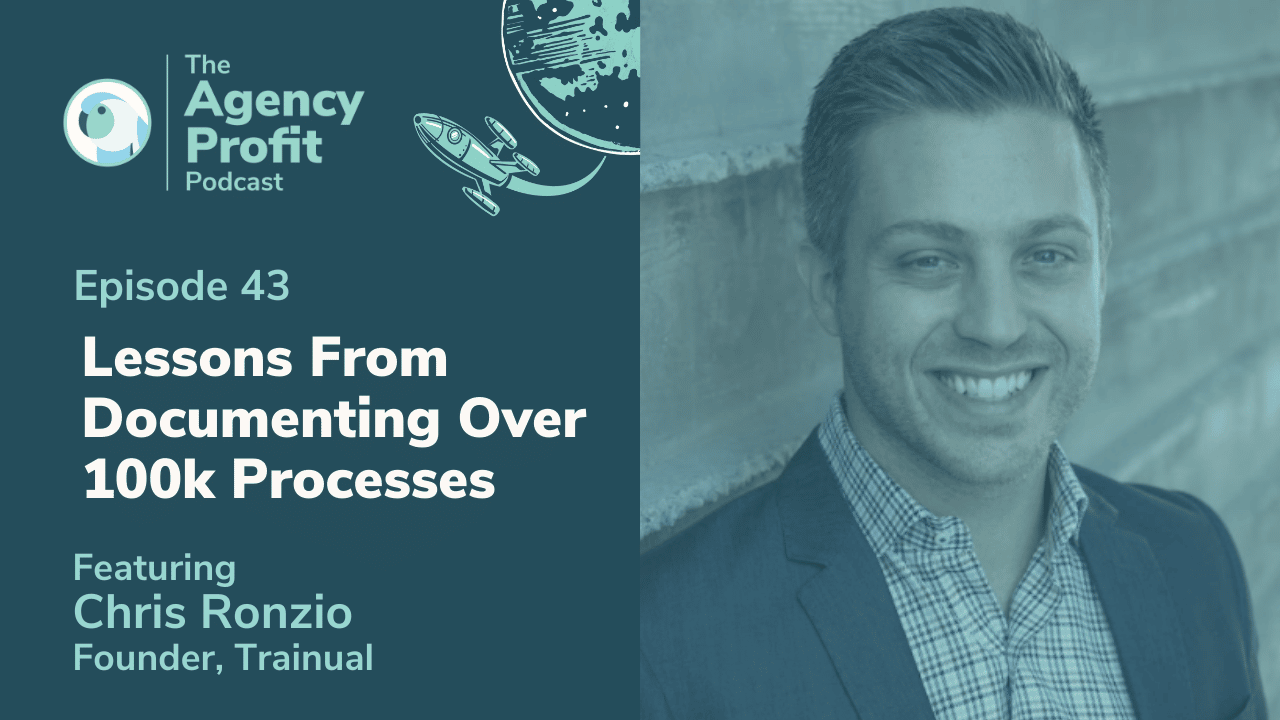Meet Chris – the ‘Ultimate Process Nerd’. He is on a mission to make small business easier by empowering leaders to document and delegate – so they can do more of what they love! Therefore, in this episode, we dive into the documentation of processes, and why it’s important for every business owner to get systemized and organized.
About Chris:
Chris Ronzio is the founder and CEO of Trainual, the leading SaaS company helping fast-growing businesses automate their onboarding and training.
Chris is also the host of the Process Makes Perfect podcast, author of 100 Hacks To Improve Your Business, and contributor to Inc. Magazine.
On the weekends, Chris and his wife take their two kids on little adventures to lakes and hiking trails. He’s enjoyed getting out of the house with COVID going on!
Points of interest…
There’s more information regarding each point in our blog notes beneath the video.
- How Trainual came to be… 1:51
- Why processes are important 3:28
- Common mistakes made when implementing processes 5:15
- What do great processes look like? 8:00
- You hack to becoming a Process Ninja 9:54
- Advice for keeping processes current and accessible 14:56
How Trainual Came To Be …
Every business owner wants a playbook for their business. They want a company that’s turnkey, scalable, and – ultimately – self-sufficient. The end goal is the option to spend less time in the office or sell your business on with relative ease.
Chris found, however, that this seemed to be an almost unattainable goal for most businesses, you know, without the usual accompanying slew of explanatory Google Docs or the hefty three-ring binder ‘Operations Manual’.
There had to be a way of simplifying processes and making them more accessible, right? And, lo, that’s when the idea for Trainual was born, leading Chris to make life easier for countless leaders and agency owners.
Why Processes Are Important
While processes are probably the most vital component to making your business more profitable, it’s rarely at the top of the ‘To Do’ list. The thought of putting the time into it – when you could be selling or working to generate money – can be offputting. It takes a really conscious effort. And that’s the hardest part.
However, processes are transformational for a business, especially when it comes to the cultivation of capacity.
“Process creates capacity. The most important thing in a business, in a small business, or in a growing business is your time – because it’s a finite resource.”
In other words, if you have more capacity – because doing the work takes less time – that leads to more profitability. Additionally, more profitability leads to more resources to invest in more people to do more work, to scale the business, and so on.
As for pinpointing what your set of processes should be? Well, that’s the million-dollar question. Why? Because it takes time to learn exactly what your company requires.
Common Mistakes Made When Implementing Processes
With so much ‘trial and error’ in play throughout the formative months, it simply doesn’t make sense to determine processes in your business’s infancy. So, mistake number one is trying to build your processes prematurely. This can lead to wasted time as the process needs to be tweaked constantly, or – worse – something slips through the net.
“You’re so eager to get rid of them that you abdicate the responsibility. You kind of push an area of the business off onto a new person that you hired, without clear instructions, because you haven’t figured it out yet.”
To ensure this doesn’t happen, feel free to use Chris’s trademarked “Do it, document it, delegate it” mantra. Don’t over-engineer the process on the first iteration because it won’t hold up in the long run. In addition to it being a time suck, it results in confusion and frustration for your team. It can also hinder scalability.
Another common mistake is investing in your system before you’ve defined your process. Chris says…
“If you’re picking the technology, the software, the tool, and then trying to develop your process, it’s not a free whiteboard kind of the situation where you can map out the best experience. So, I always recommend starting with the process, map things out, and then find the right tool that fits your process.”
What Does a Great Process Look Like?
The key to building a successful process is clear, concise communication.
“Think about it like an instruction manual. If you give someone Ikea instructions, it tells you all the tools you need – ‘here is the hammer and the stuff that came in the box.’ It’s the same with the process.”
So, some basic guide questions that should be asked in order to define a process can include:
- What software is being used/considered
- Is there a specific URL and/or passwords required
- What is a realistic time expectation
- Is this a one-person job
- What is the frequency of the job – is it on demand, or is it daily, weekly, etc.
Your Hack to Becoming a Ninja at Processes!
My favorite process is the process to build process… so I was keen to learn any Ninja tactics Chris has become privy to. The most notable one is documenting on the fly.
By way of elaboration: if you have to do a task regardless, it’s only going to take a sliver of additional time to take screenshots and pen your explanation of the process. Better still, do a screen recording if possible. Documenting your process doesn’t have to be a work of art, it just has to be A) easy to find and B) easily understood.
If you’re having issues seeing the wood for the trees and getting bogged down in what your processes “should be”, why not do what Chris does and get a new hire involved.
“When a new hire is going through something, they’re going to have more questions than anyone. They help refine the process by asking good questions.”
Pointers for Keeping Processes Current and Accessible
What is the correct cadence we should be trying to bake into a business to ensure processes stay relevant and current?
According to Chris, if you’re doing it right, your processes probably break every six to 12 months. Therefore, the cadence his team follows is every three to six months.
“So, we talk about our processes quarterly at our leadership meetings and ask if everybody’s been through recently. And then, if by the next leadership meeting, you haven’t done an audit then that’s the time you should be doing it – so three to six months is reasonable.”
If you’re reading this and don’t consider yourself to be a process-driven person, what is the easiest way to start building processes into your business? Post It notes. Yep, it’s that accessible.
“Everyone could benefit from just doing a sticky note exercise to say, ‘How do I do this thing?’ You don’t need any tech tools. You could just do sticky notes or a whiteboard and map out how you do something and then get other people to look at it.”
This way, you and your team get to see if any missing steps. Then, ask every employee to come armed with a marker, so they can draw a circle around their most problematic “sticky note.” Identifying these bottlenecks is extremely beneficial to you as a leader.
You don’t have to do all the work if you’re not the process person, just realize it’s a crowdsourced effort for everyone to understand what’s on their own plate and what, ideally, they’d like to shimmy on to someone else’s plate!
Your Take-Away
It doesn’t matter if you consider yourself naturally process-driven, or a creative, you can document your business to scale and grow.
In addition to ownership and accountability being key, you also must remember that – if/when you make any changes to your process – you must update your system!
Lastly, we challenge everyone listening to figure out what capacity their people need to be at, at their billable rate, in order to be profitable for the business.
Want to see more from Chris? Follow him @…
Did you learn anything new from this episode? If so, let us know in the comments below – we value your feedback! Our next featured expert appearing via our #APP is John Jantsch on September 30th. Meanwhile, Marcel will share more agency profitability insights on September 16th. To view our previous blogs – with Marcel and Jeremy Jackson – please make your way here…
Agency Profitability Tool Kit
If you’re looking for more resources to help you improve your agency’s profitability, then check out the Agency Profitability Tool Kit – it’s full of the same templates and checklists we’ve used with consulting clients to help them improve their profitability by over 100% in under 60 days.






0 Comments